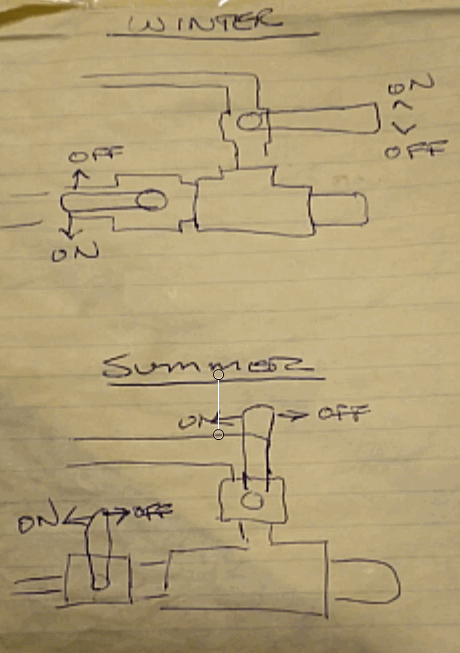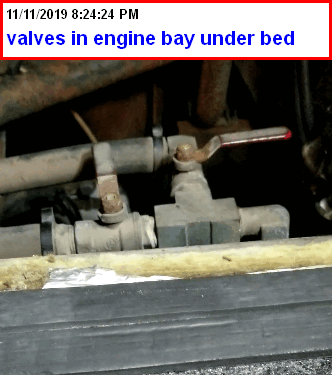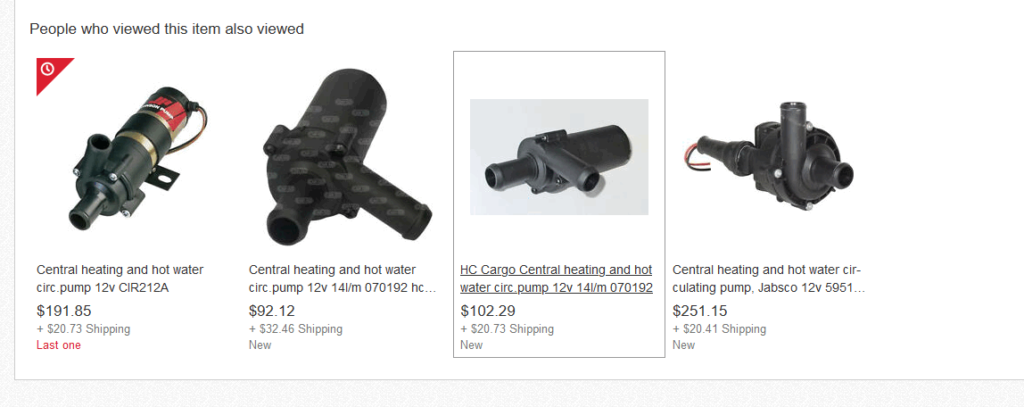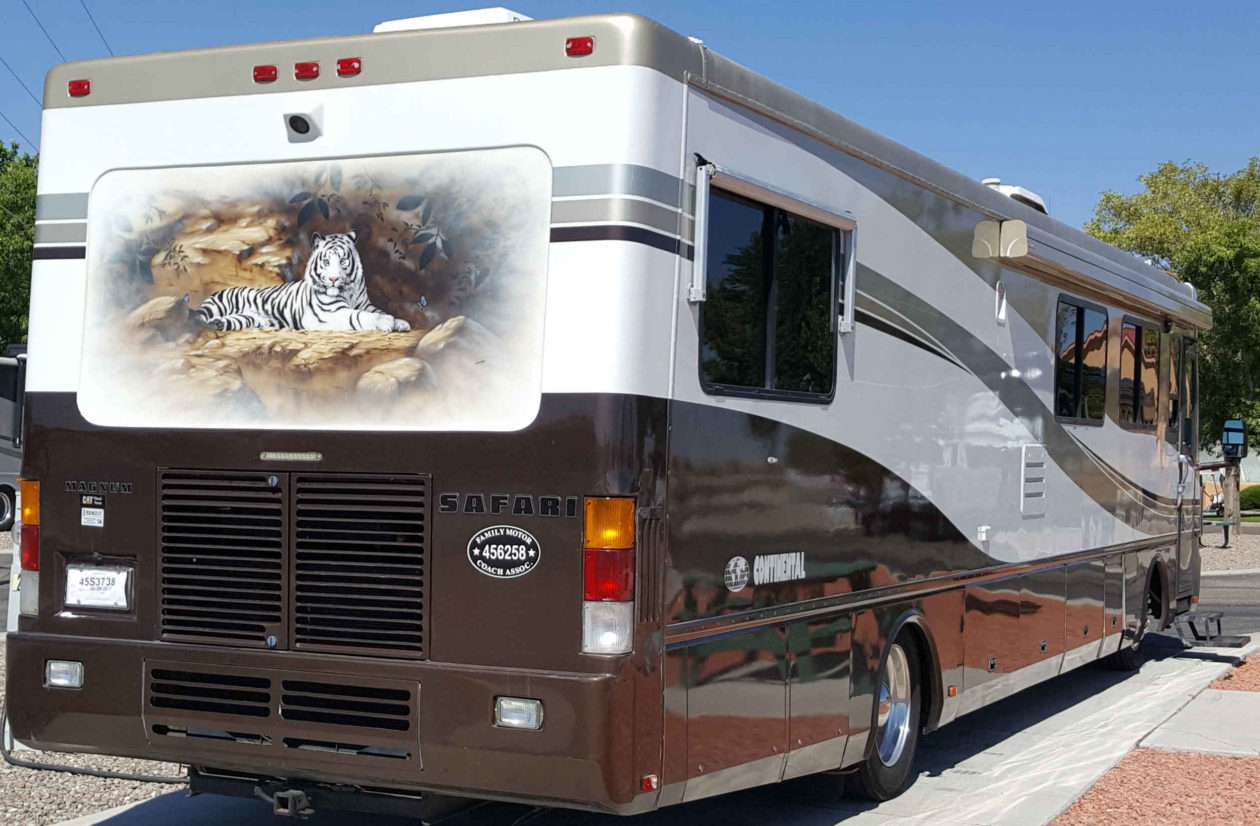Some further information may be useful and is added here. This is a short explanation on a possible cause of noise in the hurrican heater pump. The pump assembly is two units, a 12v motor and an attached pump directly driven by the motor. Included below is a short explanation of the pump assembly. Also included are some emails and the PDF manual for the pump as well as a hand drawing of the winter and summer operation position of the hurricane valves that are in the engine compartment under the bed.
From SafariFriends post:
1), the diesel fired boiler with auxiliary electric heat has been
explained. The engine heat exchanger operates in two modes, prior to a cold start it will direct coolant heater by the Hurricane hot water boiler through the engine to make for a quicker starting, smoother running, and less smokey exhaust. Once the engine is at temperature (and really under load), the coolant path from the engine to the boiler will transfer excess heat from the engine To the Hurricane heater for coach heating and hot domestic water generation while under way. There are separate switches above my entry door for these two functions.
I’ll add my 2 cents regarding the Hurricane/Oasis hydronic heating system. I’m going on my third year using one in our ’98 Serengeti. I love the Hurricane system but I have a background operating, troubleshooting, periodic maintenance, and doing minor repairs on a cranky old facility diesel boiler hydronic heating system. I can perform yearly maintenance on the Hurricane in a hour instead of the 40 or so hours it took to service that old Cleaver Brooks boiler.
Yes, they are a much more complex system than the typical separate propane furnace and hot water heater system. If you aren’t mechanical, struggle programming the clock on your microwave and don’t live on a coast where there’s marine service centers, it will be a frustrating experience owning one. If you are a person who changes their own oil, sparkplugs, belts and brakes on you car, and are ok ordering parts via the phone you’ll be fine.
The system was designed for marine use, and this is where you’ll find the majority of dealers who can get parts and have technicians who understand the systems. Some RV repair places may work on them, but it will be much more rare, although if an RV service center works on Aquahot Hydronic systems, they should be able to work on a Hurricane/Oasis system.
I’ve tried to be as thorough as possible in my description but may have missed some details. Hope this helps offer an understanding on how these systems work.
From SafariFriends post:
HEAT: Running one on a day to day basis is more complicated. You don’t just flip a switch on a thermostat and adjust the thermostat to get heat. You must first turn the system on with a master switch. This starts the boiler heating and the circulating pumps running. From that point on, as long as the master switch is on, the system will circulate water/coolant in a sealed, closed hot water loop, cycling the boiler off and on to maintain a loop temperature of 180 degrees.
HEAT ZONES – my coach has two, bedroom/bathroom, and livingroom/kitchen – each zone a fan HI/OFF/LOW speed control switch, and it’s own zone thermostat. When the fan speed switch is set to either HI or LOW, the wall thermostat will turn the fans off and on to maintain room temperature when set to “Furnace”. If the fan speed control switches are in the OFF position, the fans won’t come on even if the thermostat tells them to.
HOT WATER: When the boiler is running, a heat exchanger in the hot water tank will heat the hot water via the boiler. This is regardless of whether you are using the system to heat the interior of the coach or not. Again, the boiler will cycle off and on to maintain loop temp and this will happen if you are using a lot of hot water – this is the “Endless Hot Water” feature of the system. Boiler master switch must be on for this feature to work, but the fan speed switches and wall thermostats do not. The hot water tank will also have a 110 volt electric element activated by a switch located somewhere in the coach, either in the basement, kitchen or in my unit, in the hot water tank compartment. If you aren’t using a lot of hot water, and are plugged into shore power, there’s no need ot run the boiler but the “Endless Hot Water” feature won’t work on electric.
ENGINE HEAT: There’s a heat exchanger in the engine that will heat the hot water loop while driving. Some units require that a circulating pump switch marked “ENGINE HEAT” be on for the circulating pumps to run, but I’ve found mine doesn’t. This means you can use the furnace to provide heat to the whole coach while you drive and you’ll have hot water when you arrive at your site. To use ENGINE HEAT, you DO NOT need to turn on the boiler using the master switch.
ENGINE PRE-HEAT: The heat exchanger in the engine works in reverse too. When the boiler is on, the hot water loop includes the engine so you can use the boiler to preheat the engine in very cold weather.
SUMMER/WINTER VALVES: In the boiler compartment there are two quarter turn valves on the hot water loop hoses. With both valves in one position, water circulates through all the zones and when they are both in the other position, the hot water loop only goes to the hot water tank.
MAINTENANCE: Here’s where having basic car maintenance experience really helps. Regular system maintenance consists of changing air and fuel filters, and removing the boiler burner assembly to clean the boiler chamber, fuel nozzle and clean or replace tiny sintered bronze fuel nozzle filter and nozzle o-ring assembly. It’s recommended that you carry a spare nozzle, nozzle filter, and hot surface igniter in your rig. This will take care of 95% of system failures. NOTE: One source of repeated air in the fuel line is pinholes in the fuel line often near the fuel tank.
TROUBLESHOOTING: The #1 causes of system failure is: Air in the fuel line, a burn out hot surface igniter, and a dirty fuel nozzle. https://itrheat.com/hurricane-heating-systems/ is the best resource for maintenance and troubleshooting. They have videos showing how to maintain the system and will help troubleshoot over the phone. Being a primarily marine system, they are used to helping people get their systems running while out at sea.
FUEL CONSUMPTION: The boiler will use around 1/4 gallon of diesel per hour of operation. That’s a quarter gallon of fuel per hour that the BURNER IS RUNNING, and the burner cycles off and on during use. This makes the system very efficient. One other advantage is diesel doesn’t lose BTU capacity in cold weather and you are using fuel out of your main tank. The system can draw down the tank to 1/4 full so you have the potential for having up to 75 gallons of heating fuel on board. If the system is operating properly, the exhaust is virtually odorless and smoke free. Exhaust pipe does get VERY hot. I use a Gen-turi when camped in a campground even though the exhaust isn’t any worse than a propane furnace.
NEGATIVES: Complex to run and service compared to a regular propane furnace. Parts are expensive and professional service availability can be difficult to find. Main control boards for older systems are no longer made. System replacement costs are high. Much higher maintenance required than a standard propane furnace. If the hot water tank fails, you can’t just pick one up at your local RV parts and service center, same with system parts. The system noise is different than propane furnace and might be more annoying to some. My boiler is located right under the kitchen and makes a low rumble noise when the burner is firing. The rumble can be heard outside and can be louder than a propane furnace and exhaust noise is similar to a propane hot water heater but cycles more often when using coach heat. Each heat register has it’s own fan and they can be noisier especially on HIGH fan speed.
Tom
1998 Serengeti 3706
300hp Cat Allison 3060
FWIW, since you mentioned it has Hurricane heat be sure to familiarize yourself with the system and learn how to do periodic maintenance on the system. The Hurricane system was designed for marine use so not very many places know about this system especially away from the coasts. It is recommended you carry spare filters, a spare hot surface igniter, and a burner nozzle. Basic maintenance is pretty easy and consists of changing filters, cleaning the burner chamber, cleaning the nozzle and swapping out the nozzle and hot surface igniter when needed – keep the old ones as spares when the time comes. Brake cleaner works great for cleaning the nozzle and be aware there’s a small sintered bronze filter inside the nozzle. Replace the nozzle o-ring whenever you remove the nozzle. The Hurricane is sensitive to air in the fuel line, which can cause the unit to not fire. If this happens there’s a air bleeder valve at the top of the unit where the fuel line enters the unit. If air continues to get into the system this is an indication that the rubber fuel line has cracked or has pinholes usually near the tank where it meets the hard line. A bad o-ring at the nozzle can cause misfires also.
When you winterize no need to drain the Hurricane hot water loop as it uses antifreeze – there should be a small reservoir and overflow tank – mine is in the engine compartment but yours may be somewhere else. It’s my understanding the antifreeze in these system is NOT regular automotive antifreeze – it is a non toxic antifreeze used in domestic boiler systems due to a heat exchanger used in the hot water heater.
Bookmark this link because this is where you’ll find all the info you need for the system: http://itrheat.com/
Check out their training videos and service manuals.
They have a good reputation for helping troubleshoot over the phone because many of their customers are on boats out in the ocean far from a service center.
Enjoy the new motorhome. Hope this info helps.
Tom Masterson
1998 Serengeti 3706
300hp Cat, Allison 3060


ITR manual

